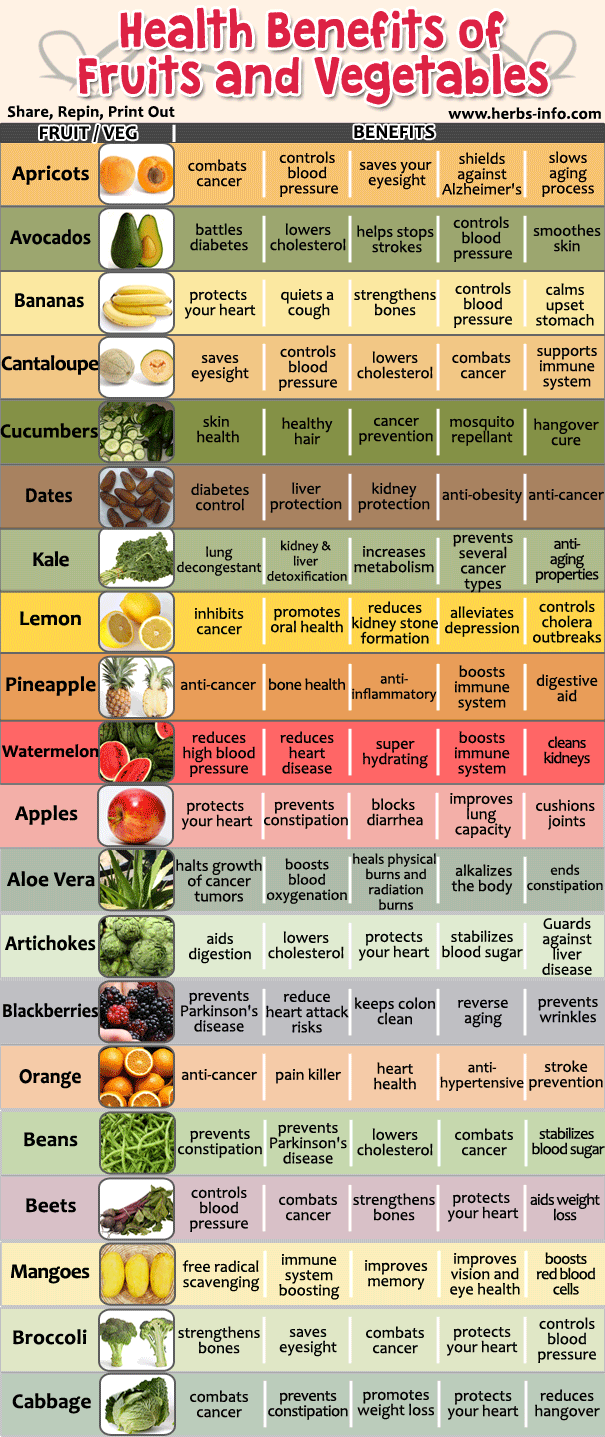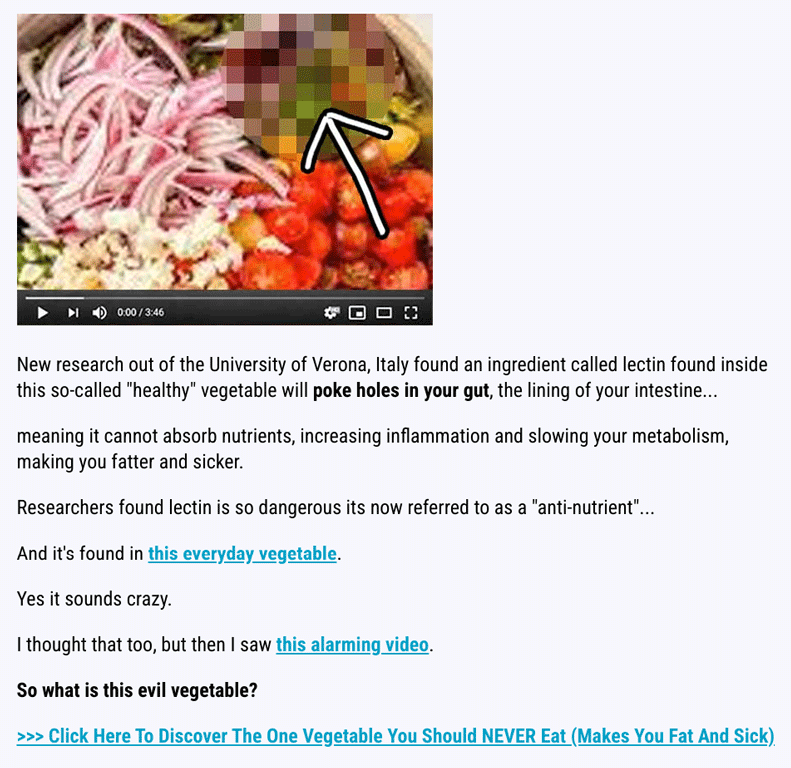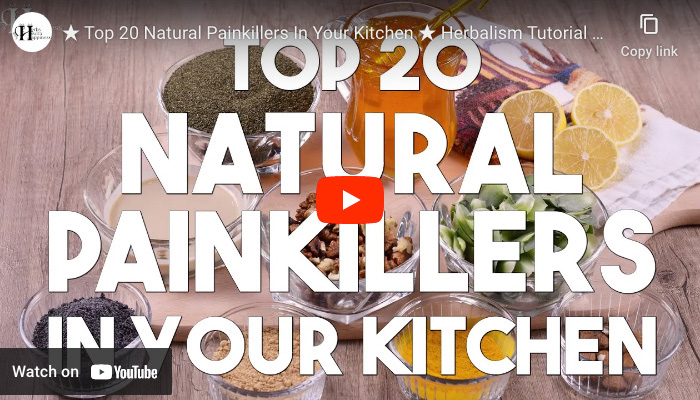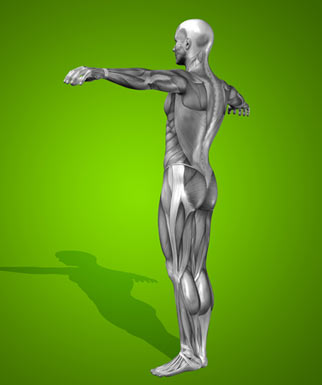 Infographic © herbshealthhappiness.com. Image sources: see foot of page
Infographic © herbshealthhappiness.com. Image sources: see foot of page
Fruits and vegetables are a vital part of a person’s diet, reducing the risk for a variety of chronic diseases like heart disease and cancer, even able to keep your weight at a healthy level. In fact, the Dietary Guidelines for Americans published in 2016 advises that half your meal should be composed of fruits and vegetables. However, there are different fruits and vegetables that account for different benefits and appear to give support for different health conditions. [1][2][3] Check out our research below:
1. Apricots
Apricots are known for their anti-inflammatory and anti-oxidant properties, making them an excellent option for boosting your immune system. Studies have also suggested that they are effective in managing inflammatory bowel disorders like ulcers (specifically ulcerative colitis) and kidney problems. In fact, the study that focused on apricots and kidney health discovered that the fruit was able to exert a protective effect on kidney cells from methotrexate-induced damage. Methotrexate is a chemotherapeutic drug known to damage the healthy cells of the kidneys. [4][5]
2. Avocados
In spite of old myths – now debunked – about avocados being high in fat and therefore “bad for the heart”, the fruit actually has cardioprotective properties. Studies have found out that avocado – especially extracts from it – is able to fight against hypertension by slowing the heart rate (bradycardia) and relaxing the blood vessels (vasodilation). In terms of nutritional value, the fat content of avocado is highly bioavailable, meaning it is easily stored and broken down by the body compared to fat from processed food. Another study also found that avocados have anti-diabetic properties as well, able to improve glucose uptake by the liver and muscles, decreasing the risk for metabolic problems that damage the nerves and blood vessels. [6][7][8]
3. Bananas
Bananas are an excellent source of dietary potassium, an electrolyte responsible for transmitting signals through the nervous system – the most important area being the muscles of the heart. People who do not have enough dietary potassium in their body often manifest cardiac problems and generalized weakness. Generally, bananas contain high levels of antioxidants and vitamins, making intake very beneficial to overall health and wellness. Antioxidants are able to clear the bloodstream of free radicals that damage healthy cells and tissues as well as giving the immune system a boost. [9][10]
4. Cantaloupe
The cantaloupe is a part of the melon family that is not only delicious and refreshing but also has numerous health benefits. A recent study published in 2012 found that extracts from cantaloupe were able to significantly reduce hyperlipidemia in test subjects fed a high cholesterol diet – even more so than Atorvastatin, an anti-hyperlipidemic drug prescribed to diabetic patients. Other benefits include its ability to improve eyesight because of high beta-carotene content. [11][12]
5. Cucumbers
Cucumbers are rich in an antioxidant substance called fisetin, which has been linked to numerous health promotion benefits – including improvement in cognitive function, analgesia, reduction of cancer risk. In a 2014 study, fisetin was able to improve cognitive function in test subjects with Alzheimer’s. Another study in 2010 found that cucumber extracts had analgesic and antioxidant properties. The chemotherapeutic activity of cucumbers was seen in a study in 2013. [13][14][15]
6. Dates
Dates have numerous benefits that promote the health of the heart, liver, and immune system. In 2014, a study discovered that dates were able to protect the liver from chemical-induced damage, typically by drugs and medications that the liver filters from the blood. A newer study in 2015 showed that dates have potent antioxidant properties, as well as an ability to prevent plaque deposition in blood vessels (the latter being responsible for atherosclerotic heart disease). [16][17]
7. Kale
Kale is known as a nutrient-rich leafy green, a favorite for salad-lovers. Studies have shown how kale is rich in highly bioavailable carbohydrates, vitamins and minerals, dietary fiber, and prebiotics – making it an excellent diet inclusion for people suffering micronutrient and calorie malnutrition. Aside from salads, kale chips can be a better alternative to potato chips. [18]
8. Lemon
The scientific name of lemon is Citrus lemon, naming it a part of the family of citrus fruits like in vitamin C, a substance that boosts immunity and protects the body from disease. Other benefits have also been discovered in recent studies, such as lemon’s cardioprotective abilities. A study published in 2014 showed that lemon had anticoagulant abilities, similar to Aspirin (a cardiac medication used to prevent clot formation and promote blood flow), and could prevent the formation of thrombi that block blood vessels and prevent the circulation of blood. [19][20]
9. Pineapple
Not only are pineapples rich in vitamin C, they are also rich in other nutrients like iron, calcium, and magnesium – and in significant amounts too! However, pineapple has also been used for hundreds of years in traditional medicine. A study in 2013 found that pineapple leaf extract was able to promote tissue repair and healing and fight against microbial infections. The extract exhibits strong anti-inflammatory properties which contributes to faster tissue repair. [21][22]
10. Watermelon
With summer upon us, watermelons have become available everywhere! The fruit is a popular choice for a cool-down snack – whether as it is or as a shake or drink. What people don’t know is that watermelons have excellent antioxidant, anti-inflammatory, and anti-cancer properties. Studies have found that watermelons are able to regulate oxidative tissue damage, lower lipid levels, and reduce the risk for cancer, heart, and metabolic diseases. [23][24]
11. Apple
An apple a day keeps the doctor away – this statement couldn’t be more true! Apples are rich in phytochemicals (naturally occurring substances) that have been linked to a decreased risk for chronic diseases like heart disease, asthma, diabetes, and even cancer. The strong antioxidant properties of the apples make them able to fight the spread of cancer cells and increases in serum cholesterol. [25]
12. Aloe Vera
In traditional folk medicine, the use of aloe vera to manage diabetic symptoms is famous in its own right. Aloe vera, typically topically used to relieve swelling and itchiness, can also manage serum glucose levels – high levels of which characterize diabetes. Another study also found that aloe vera promotes neural health, able to protect the nerves in the brain through anti-inflammatory properties. [26][27]
13. Artichoke
Artichokes are known for hepatoprotective abilities – or the ability to protect the liver from damage. A study found that artichoke – known for its scientific name as – known for its scientific name as Cynara scolymus – is hepatocurative, able to “cure” the effects of liver damage caused by toxic chemicals like carbon tetrachloride (CCI-4). Artichoke does this by reducing oxidative stress on liver tissue. You can include artichoke in your diet for a boost in antioxidants. [28]
14. Blackberries
Blackberries are typically seen on pies and cakes – but they are best eaten fresh! These fruits have high amounts of phenolic compounds, tannins, and anthocyanins, which exhibit strong antioxidant properties. Blackberries also have antibacterial abilities against H. pylori, as well as abilities to fight heart disease because of anti-inflammatory and anti-thrombotic properties. [29]
15. Oranges
Oranges are rich in vitamin C, a substance that is known as a strong immune booster. Vitamin C is able to protect us from chronic inflammatory diseases, as well as bacterial and viral conditions. Oranges have also been found to be rich in flavonoids and lycopene, which have been suggested to fight a variety of cancers. [30][31]
16. Beans
While green vegetables – including green beans – are known for their antioxidant capabilities because of high phenolic content. A study on green bean drinks published in 2015 also discovered that the vegetable can relieve fatigue. The study focused on the swimming time of athletes, which was prolonged after drinking green juice made from beans. [32]
17. Beets
The red staining power of beets is often a deterrent in choosing the vegetable despite its nutritional value. Beets have the ability to prevent and protect the kidneys from damage. Treatment with beet extracts has shown that it is able to reduce oxidative stress, inflammation, and cell death – reducing kidney damage and injury. [33]
18. Mangoes
A fruit of the tropics, mangoes are famous for their sweet and fresh taste. They are also best eaten raw (like most fruits) but are popularly used in drinks like shakes and desserts like tarts and pies. However, the real treat when it comes to mangoes is their vitamin C content and antioxidant abilities. They are anti-obesigenic, anti-inflammatory, anti-carcinogenic, and anti-diabetic. [34]
19. Broccoli
Broccoli may be a “gross vegetable” to kids, but it packs quite a punch in the nutritional department. It is a great source of phytochemicals that fight cancer and strengthen the immune system. Different studies have all supported broccoli’s ability to fight numerous health conditions like influenza (also known as the flu), reducing flu symptoms through anti-inflammatory powers, and bladder cancer, by preventing the spread of cancer cells. [35][36][37]
20. Cabbage
Cabbage is popularly used in salads and different vegetable dishes. With its rather plain taste, it is perfect to be mixed with other vegetables and varieties of meat. But despite simple flavor, it can actually fight cancer! In 2015, a study found that cabbage had the ability to inhibit tumor growth, fighting the genomes that are responsible for cancer. [38]
References:
[1] Slavin, J. & Lloyd, B. (2012). Health Benefits of Fruits and Vegetables. https://ncbi.nlm.nih.gov/pmc/articles/PMC3649719/
[2] Rautiainen, S., et. al. (2015). Higher Intake of Fruit, but Not Vegetables or Fiber, at Baseline Is Associated with Lower Risk of Becoming Overweight or Obese in Middle-Aged and Older Women of Normal BMI at Baseline. https://pubmed.ncbi.nlm.nih.gov/25934663
[3] Peleteiro, B., et. al. (2016). Worldwide burden of gastric cancer in 2012 that could have been prevented by increasing fruit and vegetable intake and predictions for 2025. https://pubmed.ncbi.nlm.nih.gov/26794617
[4] Minaiyan, M., et. al. (2014). Anti-inflammatory effect of Prunus armeniaca L. (Apricot) extracts ameliorates TNBS-induced ulcerative colitis in rats. https://pubmed.ncbi.nlm.nih.gov/25657793
[5] Vardi, N., et. al. (2013). The protective effects of Prunus armeniaca L (apricot) against methotrexate-induced oxidative damage and apoptosis in rat kidney. https://pubmed.ncbi.nlm.nih.gov/23143813
[6] Ojewole, J., et. al. (2007). Cardiovascular effects of Persea Americana Mill (Lauraceae) (avocado) aqueous leaf extract in experimental animals. https://blues.sabinet.co.za/WebZ/Authorize?sessionid=0:autho=pubmed:password=pubmed2004&/AdvancedQuery?&format=F&next=images/ejour/cardio/cardio_v18_n2_a2.pdf
[7] Dzeufiet, P., et. al. (2014). Antihypertensive potential of the aqueous extract which combine leaf of Persea americana Mill. (Lauraceae), stems and leaf of Cymbopogon citratus (D.C) Stapf. (Poaceae), fruits of Citrus medical L. (Rutaceae) as well as honey in ethanol and sucrose experimental model. https://ncbi.nlm.nih.gov/pmc/articles/PMC4301628/
[8] Lima, C., et. al. (2012). Anti-diabetic activity of extract from Persea americana Mill. leaf via the activation of protein kinase B (PKB/Akt) in streptozotocin-induced diabetic rats. https://pubmed.ncbi.nlm.nih.gov/22472105
[9] University of Maryland Medical Center. Potassium. https://umm.edu/health/medical/altmed/supplement/potassium
[10] Singh, B., et. al. (2016). Bioactive compounds in banana and their associated health benefits – A review. https://pubmed.ncbi.nlm.nih.gov/27041291
[11] Bidkar, J., et. al. (2012). Anti-hyperlipidemic activity of Cucumis melo fruit peel extracts in high cholesterol diet induced hyperlipidemia in rats. https://pubmed.ncbi.nlm.nih.gov/23023565
[12] Fleshman, M., et. al. (2011). Carotene and novel apocarotenoid concentrations in orange-fleshed Cucumis melo melons: determinations of β-carotene bioaccessibility and bioavailability. https://pubmed.ncbi.nlm.nih.gov/21417375
[13] Khan, N., et. al. (2013). Fisetin: A Dietary Antioxidant for Health Promotion. https://ncbi.nlm.nih.gov/pmc/articles/PMC3689181/
[14] Currais, A., et. al. (2014). Modulation of p25 and inflammatory pathways by fisetin maintains cognitive function in Alzheimer’s disease transgenic mice. https://ncbi.nlm.nih.gov/pmc/articles/PMC3954948/
[15] Kumar, D., et. al. (2010). Free Radical Scavenging and Analgesic Activities of Cucumis sativus L. Fruit Extract. https://ncbi.nlm.nih.gov/pmc/articles/PMC3019374/
[16] Abdelaziz, D. & Ali, S. (2014). The protective effect of Phoenix dactylifera L. seeds against CCl4-induced hepatotoxicity in rats. https://pubmed.ncbi.nlm.nih.gov/24945397
[17] Borochov-Neori, H., et. al. (2015). Antioxidant and antiatherogenic properties of phenolic acid and flavonol fractions of fruits of ‘Amari’ and ‘Hallawi’ date (Phoenix dactylifera L.) varieties. https://pubmed.ncbi.nlm.nih.gov/25765921
[18] Migliozzi, M., et. al. (2015). Lentil and Kale: Complementary Nutrient-Rich Whole Food Sources to Combat Micronutrient and Calorie Malnutrition. https://pubmed.ncbi.nlm.nih.gov/26569296
[19] Riaz, A., et. al. (2014). In vitro/in vivo effect of Citrus limon (L. Burm. f.) juice on blood parameters, coagulation and anticoagulation factors in rabbits. https://pubmed.ncbi.nlm.nih.gov/25015459
[20] Strohle, A. & Hahn, A. (2009). Vitamin C and immune function. https://pubmed.ncbi.nlm.nih.gov/19263912
[21] United States Department of Agriculture. Pineapple, raw, all varieties. https://ndb.nal.usda.gov/ndb/foods/show/2340?fgcd=&manu=&lfacet=&format=&count=&max=35&offset=&sort=&qlookup=09266
[22] Dutta, S. & Bhattacharyya, D. (2013). Enzymatic, antimicrobial and toxicity studies of the aqueous extract of Ananas comosus (pineapple) crown leaf. https://pubmed.ncbi.nlm.nih.gov/24076462
[23] Mohammad, M., et. al. (2014). Watermelon (Citrullus lanatus (Thunb.) Matsum. and Nakai) juice modulates oxidative damage induced by low dose X-ray in mice. https://pubmed.ncbi.nlm.nih.gov/24877107
[24] Hong, M., et. al. (2014). Watermelon consumption improves inflammation and antioxidant capacity in rats fed an atherogenic diet. https://pubmed.ncbi.nlm.nih.gov/25631716
[25] Boyer, J. & Liu, R. (2004). Apple phytochemicals and their health benefits. https://nutritionj.biomedcentral.com/articles/10.1186/1475-2891-3-5
[26] Suksomboon, N., Poolsup, N. & Punthanitisarn, S. (2016). Effect of Aloe vera on glycaemic control in prediabetes and type 2 diabetes: a systematic review and meta-analysis. https://pubmed.ncbi.nlm.nih.gov/27009750
[27] Guven, M., et. al. (2016). The effect of aloe vera on ischemia-Reperfusion injury of sciatic nerve in rats. https://pubmed.ncbi.nlm.nih.gov/27044829
[28] Colak, E., et. al. (2016). The hepatocurative effects of Cynara scolymus L. leaf extract on carbon tetrachloride-induced oxidative stress and hepatic injury in rats. https://ncbi.nlm.nih.gov/pmc/articles/PMC4771653/
[29] Oszmianski, J., et. al. (2015). Determination of Phenolic Compounds and Antioxidant Activity in Leaves from Wild Rubus L. Species. https://mdpi.com/1420-3049/20/3/4951/htm
[30] Chen, J., et. al. (2015). Comparative study of flavonoid production in lycopene-accumulated and blonde-flesh sweet oranges (Citrus sinensis) during fruit development. https://pubmed.ncbi.nlm.nih.gov/25872450
[31] Sorice, A., et. al. (2014). Ascorbic acid: its role in immune system and chronic inflammation diseases. https://pubmed.ncbi.nlm.nih.gov/24766384
[32] Qi, L. & Ying, L. (2015). The Research on the Impact of Green Beans Sports Drinks on Relieving Fatigue in Sports Training. https://ncbi.nlm.nih.gov/pmc/articles/PMC4774396/
[33] Gamal, A., et. al. (2014). Beetroot (Beta vulgaris L.) Extract Ameliorates Gentamicin-Induced Nephrotoxicity Associated Oxidative Stress, Inflammation, and Apoptosis in Rodent Model. https://ncbi.nlm.nih.gov/pmc/articles/PMC4221885/
[34] Wall-Medrano, A., et. al. (2015). Mango: agroindustrial aspects, nutritional/functional value and health effects. https://pubmed.ncbi.nlm.nih.gov/25561099
[35] Vasanthi, H., Mukherjee, S. & Das, D. (2009). Potential Health Benefits of Broccoli- A Chemico-Biological Overview. https://ingentaconnect.com/content/ben/mrmc/2009/00000009/00000006/art00011
[36] Noah, T., et. al. Effect of broccoli sprouts on nasal response to live attenuated influenza virus in smokers: a randomized, double-blind study. https://pubmed.ncbi.nlm.nih.gov/24910991
[37] Bhandari, S. & Kwak, J. (2015). Chemical composition and antioxidant activity in different tissues of brassica vegetables. https://pubmed.ncbi.nlm.nih.gov/25591122
[38] Lozano-Baena, M., et. al. (2015). Antigenotoxicity and Tumor Growing Inhibition by Leafy Brassica carinata and Sinigrin. https://pubmed.ncbi.nlm.nih.gov/26343628
Image Sources:
pineapple – https://en.wikipedia.org/wiki/File:Pineapple_and_cross_section.jpg
kale – https://en.wikipedia.org/wiki/File:Kale-Bundle.jpg
cucumber – https://en.wikipedia.org/wiki/File:Kurkkuja.jpg
watermelon – https://en.wikipedia.org/wiki/File:Watermelons.jpg
lemon – https://en.wikipedia.org/wiki/File:Lemon.jpg
dates – https://en.wikipedia.org/wiki/File:Dattes_deglet_from_Biskra.jpg
mango – https://en.wikipedia.org/wiki/File:Sindhri_Mango.JPG
orange – https://commons.wikimedia.org/wiki/File:Ambersweet_oranges.jpg
blackberries – https://en.wikipedia.org/wiki/Blackberry
aloe vera – https://en.wikipedia.org/wiki/File:Aloe_Vera.jpg
apricot – https://en.wikipedia.org/wiki/File:Apricot_and_cross_section.jpg
artichokes – https://commons.wikimedia.org/wiki/File:Artichokes_(4701356726).jpg
avocado – https://en.wikipedia.org/wiki/File:Avocado.jpeg
banana – https://en.wikipedia.org/wiki/File:Bananas_white_background.jpg
beans – https://commons.wikimedia.org/wiki/File:Beans_vegetable.jpg
beets – https://en.wikipedia.org/wiki/File:Beets-Bundle.jpg
blueberry – https://upload.wikimedia.org/wikipedia/commons/thumb/d/da/CDC_blue.jpg/120px-CDC_blue.jpg
broccoli – https://upload.wikimedia.org/wikipedia/commons/thumb/0/03/Broccoli_and_cross_section_edit.jpg/220px-Broccoli_and_cross_section_edit.jpg
cantaloupe – https://en.wikipedia.org/wiki/File:Canteloupe_and_cross_section.jpg
★ Get My Books - 100% FREE:
😳 Tinnitus And Brain Health?
After 47 years of studies and countless brain scans done on more than 2,400 tinnitus patients, scientists at the MIT Institute found that in a shocking 96% of cases, tinnitus was actually shrinking their brain cells.
As it turns out, tinnitus and brain health are strongly linked.
Even more interesting: The reason why top army officials are not deaf after decades of hearing machine guns, bombs going off and helicopter noises…
Is because they are using something called "the wire method", a simple protocol inspired by a classified surgery on deaf people from the 1950s...
★ How To Get Rid Of Nail Fungus:
★ Does Your Salad Contain This Vegetable?
★ 20 Natural Painkillers In Your Kitchen (Video):
★ Men's Prostate Health:

2. Famous Chef Sheds 60lbs Researching New Paleo Recipes: Get The Cookbook FREE Here
3. #1 muscle that eliminates joint and back pain, anxiety and looking fat
4. 7 odd foods that KILL your abdominal fat (surprising fat-fighters)
5. The TRUTH about bread (Will surprise you!)
6. [PROOF] Reverse Diabetes with a "Pancreas Jumpstart"
7. Here's What Happens When You "Unlock Your Hip Flexors"
8. The #1 WORST food that CAUSES Faster Aging (beware -- Are you eating this?)
The #1 Muscle That Eliminates Joint And Back Pain, Anxiety And Looking Fat
By Mike Westerdal CPT
Can you guess which muscle in your body is the #1 muscle that eliminates joint and back pain, anxiety and looking fat?
This is especially important if you spend a significant amount of time sitting every day (I do, and this really affects me in a big way!)
Working this "hidden survival muscle" that most people are simply not training because no-one ever taught them how will boost your body shape, energy levels, immune system, sexual function, strength and athletic performance when unlocked.
If this "hidden" most powerful primal muscle is healthy, we are healthy.
Is it...
a) Abs
b) Chest
c) Glutes
d) Hip Flexors
Take the quiz above and see if you got the correct answer!
P.S. Make sure you check out this page to get to know the 10 simple moves that will bring vitality back into your life:
If you enjoyed this page:














